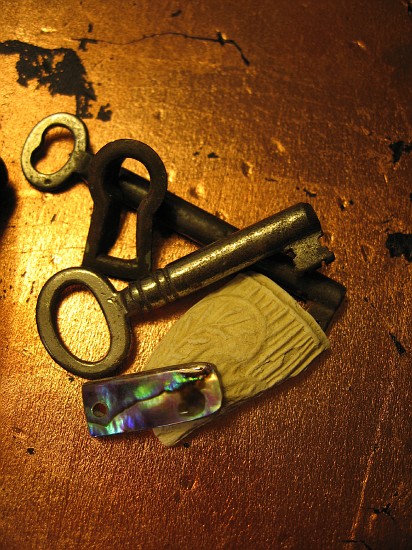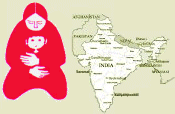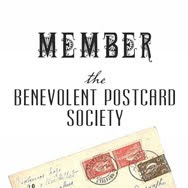gar·bage // <
Dustmen and their cart
This “dust” as well as that swept from the streets went to the dust-yards where many of the city’s working poor spent their days working through the huge heaps of dust removing what was large enough to pick out by hand and sifting through sieves the rest. Metal, wood, bone, pieces of jewellery, cutlery, dead cats (for their pelts!), bits of coal, potash… a limitless list of things could and were gleaned from the Victorian dust heap.
Even the dust, itself had value.
“These Dust-heaps are a wonderful compound of things. A banker’s cheque for a considerable sum was found in one of them. It was on Merries & Farquhar, in 1847. But bankers’ cheques, or gold and silver articles, are the least valuable of their ingredients. Among other things, a variety of useful chemicals are extracted. Their chief value, however, is for the making of bricks. The fine cinder-dust and ashes are used in the clay of the bricks, both for the red and gray stacks. Ashes are also used as fuel between the layers of the clump of bricks, which could not be burned in that position without them. The ashes burn away, and keep the bricks open. Enormous quantities are used. In the brickfields at Uxbridge, near the Drayton Station, one of the brickmakers alone will frequently contract for fifteen or sixteen thousand chaldrons of this cinder-dust, in one order. Fine coke, or coke-dust, affects the market at times as a rival; but fine coal, or coal-dust, never, because it would spoil the bricks.” “Dust; or Ugliness Redeemed” Household Words, 13 July 1850
Dust heaps were such a money-maker that men could sell their heaps for thousands of pounds. Of course, they only made money for their owners. The workers still made starvation wages. Caught stealing anything of value lost you your job and could get you transported to Australia.

- Dust-sifters “London Labour and the London Poor” Henry Mayhew
Even dog shit (called “pure”), night soil and urine had its buyers in old London. Used by leather tanners in their trade, they were commodities and was sold out the back door of homes, wealthy and not so.
For more information about Victorian London than you might ever need to know, check out the Victorian Dictionary, and immense glossary of all things Victorian London!
According to an article called “19th century London dust-yards: A case study in closed-loop resource efficiency”, by Costas A. Velis, David C. Wilson and Christopher R. Cheeseman:
“The emergence of lucrative markets for ‘soil’ and ‘breeze’ products encouraged dust-contractors to recover effectively 100% of the residual wastes remaining after readily saleable items and materials had been removed by the thriving informal sector. Contracting dust collection to the private sector allowed parishes to keep the streets relatively clean, without the need to develop institutional capacity, and for a period this also generated useful income. The dust-yard system is, therefore, an early example of organised, municipal-wide solid waste management, and also of public–private sector participation. The dust-yard system had been working successfully for more than 50 years before the Public Health Acts of 1848 and 1875, and was thus important in facilitating a relatively smooth transition to an institutionalised, municipally-run solid waste management system in England…. In addition, there are analogies between dust-yards and informal sector recycling systems currently operating in many developing countries.”
In India, recycling or materials of all sorts is a growing and lucrative business for some. Whole streets have become devoted to the sale, recycling and resale of materials from cardboard, to plastics to metals to glass.
Many cities have, in the past, used garbage to create artificial shorelines for their cities. When I lived in New York City, I lived on City Island in the Bronx. Much of the island’s shoreline was expanded using the detritus from Manhattan and the Bronx. When I used to walk on the little beach at the end of my street, I used to come up with all sorts of treasures from the past. Shards of broken pottery and glass, porcelain door-knobs and dolls, and glass bottle-stoppers were just a few of the things I would find.
More recently, I would beach-comb up along the Upper Ottawa River where I would find arrowheads and sherds (well, one, anyway) from Indian pottery.
Pot Sherd (l), arrowheads (near l), scrapers (c), and flakes (r)
![]() At the point in front of the old Hudson’s Bay post, I found pieces of broken pottery from both the old post, as well as the nearby former hotel, and pieces of old clay trading pipes, buttons, knife handles worn smooth from the waves…. and more… All someone’s long-forgotten garbage.
At the point in front of the old Hudson’s Bay post, I found pieces of broken pottery from both the old post, as well as the nearby former hotel, and pieces of old clay trading pipes, buttons, knife handles worn smooth from the waves…. and more… All someone’s long-forgotten garbage.

- Bits and pieces
It makes me wonder if all the little treasures I possess will one day end up in someone else’s collection and they will wonder about who made them, who owned them, and how they came to be in the garbage…

- Bits and pieces

- Relics

- More relics






Bella said,
July 24, 2009 at 4:43 pm
What a wonderful post! LOVED reading the historical info and look at the beautiful items you’ve found. The St Christopher pendant looks very much like one that I myself found a few years ago…It’s always worth looking down- isn’t it? You never know what treasures you’ll find!
Mrs. Mecomber said,
July 18, 2009 at 7:34 pm
What a riveting post!!!!!!!! Loved it! I love history and learning about such things. Thanks for visiting my PH Garbage last week, and leaving your link. I’m so glad I did not miss this post. (I think the same way about relics/garbage– who will own this after me, and what will they be thinking?)
Mrs. Mecomber
http://newyorktraveler.net
Have a good weekend!
Annie said,
July 13, 2009 at 4:27 pm
I enjoyed reading this post and looking at your treasures!
Thanks for visiting mine. Isn’t Bread and Tulips a beautiful movie? I hope you get to Venice one of these days!
Irene said,
July 13, 2009 at 4:05 pm
Interesting “garbage” you have there.
Thanks for dropping by 🙂
Briana said,
July 13, 2009 at 10:54 am
Awesome information!! As a homeschooling mom, this is definitely something that I will re-read with the kids. I love this kind of stuff! 🙂
Thanks for visiting my “garbage” post, too!
healingmagichands said,
July 12, 2009 at 10:26 pm
I’m glad I felt motivated to come over here. I had no idea there was so much to say about garbage and I really appreciate the little history lesson. It was great to have it capped by the lovely photos of your relics and bits and pieces.
It makes me feel a lot better about all the little piles of relics and bits and pieces I have around here. There is something comforthing about knowing that my predilection for such items is shared.
mudhooks said,
July 12, 2009 at 11:03 pm
It seems it is (refreshingly) shared with a number of people.
Many of the things I own have been things just lying about in a drawer or a box since my childhood. I can recall taking them out and looking at them and my mother explaining where they came from and how they came to be or how they came to be in the drawer.
The last photos is a cross section.
A coin found in amongst my father’s things when he died (the large Victoria “jubilee” coin); the locket with photos of my mother’s G-grandparents (paternal, I think); the pin with a fragment of butterfly wing under glass was my mother’s mother’s; the dolphin cufflink, one of a pair I dare not wear in case I lose them, also my grandmother’s; the WWII “record and destroy” tags my mother kept after the war (I never knew if it was the documents or the tags that were supposed to be destroyed, or both!); the little seed with ivory elephant “stopper” containing 50 tiny, ivory sliver, baby elephants (bought by me before the ivory ban); gold coins left me by my step-fathers’ sister, Aunt Amy, who I came to love a few years before she died when we both “understood each other” (coins now in a safety-deposit box!), and given to my despite the best efforts of her sister how apparently hates me and has done since I was 11; and a plastic guitar pick found on a street somewhere….
Sadly, I have no one to pass along not just the things to but the meaning or the experience of remembering all the drawers and boxes they sat in until they received them, or, even, imagining their past before the first time they remember seeing them as a child. Even remembering the feeling of them in their hands over the years.
That really makes me very sad.
billco1 said,
July 12, 2009 at 9:13 pm
Interesting post. I love digging in old garbage, especially that of Native Americans. Have arrowheads and Native American stone tools hanging on my walls.
Dawn said,
July 12, 2009 at 8:27 pm
A very interesting post. Thanks for such an informative post; I learnt a lot. I have a house full of such treasures as well. I think if I were an artist, I could make something of them.
SnoopyTheGoon said,
July 12, 2009 at 8:02 pm
That was an amazing post and great pictures. Thanks for sharing. And for visiting.
Have a great week!
lissa said,
July 12, 2009 at 7:25 pm
wow, lots of information here, I like beachcombing as well, finding discard pieces of other people’s memories, makes me wonder about how we value things and why we choose to discard them at will
imDavidLee said,
July 12, 2009 at 7:02 pm
when talk about garbage..i will think about Malaysia country 1st..haha
Annie said,
July 12, 2009 at 6:39 pm
This is such a great post. Love the history and the photos of your treasures.
Thanks for visiting mine. Isn’t Bread and Tulips a sweet movie? I hope that you make it to Venice someday soon!
mudhooks said,
July 12, 2009 at 8:25 pm
One day!
liferamblings said,
July 12, 2009 at 5:40 pm
this is such an interesting read and the pics are all lovely. happy weekend.
Sue said,
July 12, 2009 at 5:26 pm
I enjoyed the history lesson, and your photos. 🙂 I had no idea about the dust heaps or dust -men before. Thanks so much for stopping by 🙂
Jerry said,
July 12, 2009 at 5:25 pm
Thanks for an informative post! It is always neat to be out exploring and find treasures that others have cast off. You have some great shots of yours.
Marites said,
July 12, 2009 at 4:57 pm
This is really informative and quite interesting:) I like the pics too.
Tara R. said,
July 12, 2009 at 4:37 pm
This is an amazing post. I didn’t know about the dust yards. This makes me want to get out my old metal detector and go treasure hunting.
jams O'Donnell said,
July 12, 2009 at 4:29 pm
What a wonderful post Anneke. I think the worst job mentioned by Henry Mayhew must be the pure collectors.
You have found some wonderful stuff. Perhaps one day I wuill do the same along the banks of the Thames!
mudhooks said,
July 12, 2009 at 8:24 pm
I cannot tell you how much I wanted to go down on the Thames mud at low tide, just to be able to walk about and see if I could find something! Every time my ex and I went, he would promise we could and every time we would end up doing something HE wanted to do.
One day…. sighhhhh…
I do love London and spend a LOT of time there, if only vicariously.
Your EG Tour Guide said,
July 12, 2009 at 4:06 pm
What a nice surprise to find someone has explored this week’s theme with photos and “value-added” information. Who’d have thought garbage could be so interesting!
Yami said,
July 12, 2009 at 3:49 pm
A very comprehensive take for this week’s theme. Congrats!
Dragonstar said,
July 12, 2009 at 3:31 pm
We used to safe jam jars for the rag-&-bone men, and sometimes get a golfish as a reward. All our ashes (many years ago!) went in the back lane for the dust men. Thanks for the memories.
A. said,
July 12, 2009 at 1:46 pm
The rag & bone men, as such, continued in living memory in some areas of the UK. They often made a very good living from judicious use of other people’s garbage. In the 60s and 70s there was even a TV comedy, Steptoe & Son, which featured rag & bone men. Even these days there are junk collectors in some areas – same thing, new name. The newest name of course is recycling.
julie said,
July 12, 2009 at 10:28 am
Those relics! These are precious things and I like hem 😀
Mar said,
July 12, 2009 at 9:31 am
Excellent!! what a wonderful surprise to read your post among all the “garbage” !! Love your shots.
Happy weekend !
Gattina said,
July 12, 2009 at 9:26 am
I never thought I would read an article about garbage ! but your post was very interesting to read, especially what London concerned !
I don’t mind to seperate the garbage, what disturbes me are the costs. Respecting the law can become very expensive for a household with poor money and that is not right. I mean not only we have taxes to pay for garbage but also the plastic bags ! We are only two, imagine a family with 3 children !
mudhooks said,
July 12, 2009 at 10:02 am
That upsets me, too. Especially as others who create more garbage can afford to be wasteful AND buy the bags to throw away their extra trash.
Luckily, here, our municipal taxes cover the cost. Of course, the very people who complain about having to pay all the extra taxes are the very reason our recycling programs cost so much.
A few years ago, too, we found out that while we took the time and trouble to separate and recycle our glass bottles, the city wasn’t actually recycling them. They just took them to the landfill! Their excuse was that it “cost them too much to recycle them”. Meanwhile, we were paying the taxes for a recycling program and feeling like we were DOING something worthwhile and the city was just doing the “expedient thing”.
There was such a stink (pardon the pun) that the city was forced to stop landfilling the glass and store it until they could find a way of recycling it, which, thankfully, they are now doing….
Ritsumei said,
July 12, 2009 at 8:23 am
Interesting. Makes our “reduce, reuse, recycle” efforts look rather paltry. Thanks for visiting my blog.
srp said,
July 12, 2009 at 4:03 am
Wow! What a great history lesson.. I learn something new each time I visit. Thanks!
azahar said,
July 12, 2009 at 3:08 am
Pithy as usual. 😉
I like the keys a lot.
mudhooks said,
July 12, 2009 at 3:42 am
I actually had some things I had made out of things I had found in my beach-combing but can’t find them… Must be somewhere. I just don’t know where. I would have photographed them if I had found them.
VioletSky said,
July 12, 2009 at 1:51 am
You always have the most interesting reading!
And the light (glow) on your relics is sublime.